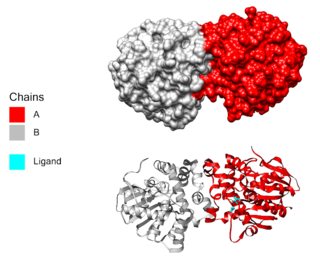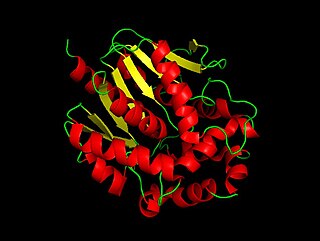
In organic chemistry, an acyl halide is a chemical compound derived from an oxoacid by replacing a hydroxyl group with a halide group.
4-Hydroxybenzoic acid, also known as p-hydroxybenzoic acid (PHBA), is a monohydroxybenzoic acid, a phenolic derivative of benzoic acid. It is a white crystalline solid that is slightly soluble in water and chloroform but more soluble in polar organic solvents such as alcohols and acetone. 4-Hydroxybenzoic acid is primarily known as the basis for the preparation of its esters, known as parabens, which are used as preservatives in cosmetics and some ophthalmic solutions. It is isomeric with 2-hydroxybenzoic acid, known as salicylic acid, a precursor to aspirin, and with 3-hydroxybenzoic acid.
Dehalococcoides is a genus of bacteria within class Dehalococcoidia that obtain energy via the oxidation of hydrogen and subsequent reductive dehalogenation of halogenated organic compounds in a mode of anaerobic respiration called organohalide respiration. They are well known for their great potential to remediate halogenated ethenes and aromatics. They are the only bacteria known to transform highly chlorinated dioxins, PCBs. In addition, they are the only known bacteria to transform tetrachloroethene to ethene.
The crotonase family comprises mechanistically diverse proteins that share a conserved trimeric quaternary structure, the core of which consists of 4 turns of a (beta/beta/alpha)n superhelix.
Dichloromethane dehalogenase (EC 4.5.1.3; systematic name dichloromethane chloride-lyase (adding H2O; chloride-hydrolysing; formaldehyde-forming)) is a lyase enzyme that generates formaldehyde.
In enzymology, a phenylacetaldoxime dehydratase (EC 4.99.1.7) is an enzyme that catalyzes the chemical reaction
In enzymology, a 4-chlorobenzoate dehalogenase (EC 3.8.1.6) is an enzyme that catalyzes the chemical reaction
In enzymology, an alkylhalidase (EC 3.8.1.1) is an enzyme that catalyzes the chemical reaction

In enzymology, a haloacetate dehalogenase (EC 3.8.1.3) is an enzyme that catalyzes the chemical reaction

In enzymology, a haloalkane dehalogenase (EC 3.8.1.5) is an enzyme that catalyzes the chemical reaction
In enzymology, a (R)-2-haloacid dehalogenase(EC 3.8.1.9), DL-2-haloacid halidohydrolase (inversion of configuration), DL-DEXi, (R,S)-2-haloacid dehalogenase (configuration-inverting)) is an enzyme that catalyzes the chemical reaction
In enzymology, a (S)-2-haloacid dehalogenase (EC 3.8.1.2) is an enzyme that catalyzes the chemical reaction
In enzymology, a 4-chlorobenzoate—CoA ligase is an enzyme that catalyzes the chemical reaction
The enzyme 4-hydroxybenzoyl-CoA thioesterase (EC 3.1.2.23) catalyzes the reaction
In enzymology, a glutaryl-7-aminocephalosporanic-acid acylase (EC 3.5.1.93) is an enzyme that catalyzes the chemical reaction

The fluorinase enzyme catalyzes the reaction between fluoride ion and the co-factor S-adenosyl-L-methionine to generate L-methionine and 5'-fluoro-5'-deoxyadenosine, the first committed product of the fluorometabolite biosynthesis pathway. The fluorinase was originally isolated from the soil bacterium Streptomyces cattleya, but homologues have since been identified in a number of other bacterial species, including Streptomyces sp. MA37, Nocardia brasiliensis and Actinoplanes sp. N902-109. This is the only known enzyme capable of catalysing the formation of a carbon-fluorine bond, the strongest single bond in organic chemistry.
Pentachlorophenol monooxygenase (EC 1.14.13.50, pentachlorophenol dechlorinase, pentachlorophenol dehalogenase, pentachlorophenol 4-monooxygenase, PCP hydroxylase, pentachlorophenol hydroxylase, PcpB, PCB 4-monooxygenase, PCB4MO) is an enzyme with systematic name pentachlorophenol,NADPH:oxygen oxidoreductase (hydroxylating, dechlorinating). This enzyme catalyses the following chemical reaction
2-haloacid dehalogenase (configuration-inverting) (EC 3.8.1.10, 2-haloalkanoic acid dehalogenase, 2-haloalkanoid acid halidohydrolase, DL-2-haloacid dehalogenase, DL-2-haloacid dehalogenase (inversion of configuration), DL-2-haloacid halidohydrolase (inversion of configuration), DL-DEXi, (R,S)-2-haloacid dehalogenase (configuration-inverting)) is an enzyme with systematic name (S)-2-haloacid dehalogenase (configuration-inverting). This enzyme catalyses the following chemical reaction
Adsorbable Organic Halides (AOX) is a measure of the organic halogen load at a sampling site such as soil from a land fill, water, or sewage waste. The procedure measures chlorine, bromine, and iodine as equivalent halogens, but does not measure fluorine levels in the sample.
Reductive dehaholagenses (EC 1.97.1.8) are a group of enzymes utilized in organohalide respiring bacteria. These enzymes are mostly attached to the periplasmic side of the cytoplasmic membrane and play a central role in energy-conserving respiratory process for organohalide respiring bacteria by reducing organohalides. During such reductive dehalogenation reaction, organohalides are used as terminal electron acceptors. They catalyze the following general reactions:




